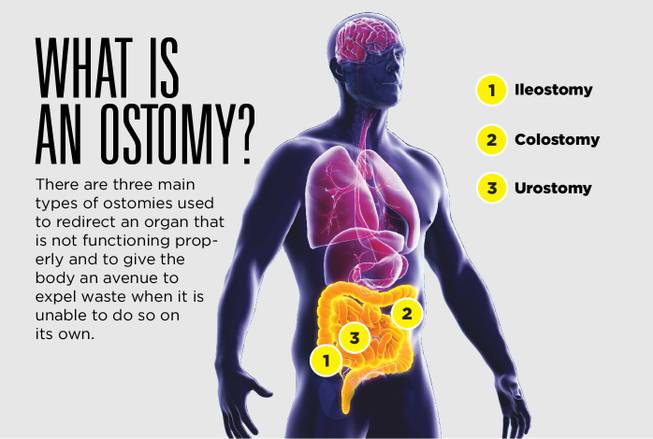
Sunday, April 24, 2016 | 2 a.m.
Because of stigmas, misinformation and social discomfort, ostomies often are not discussed. But with nearly 750,000 people living in the United States with one, it’s time for that dialogue to begin.
An ostomy is a surgically created opening that reroutes the small intestine, colon or bladder into a pouch outside of the body. Ostomies are put in place for different reasons and can be permanent or temporary.
“Ostomies can deeply improve so many people’s lives, but it is a sensitive subject and it can take a lot of adjustment before the person — called an ostomate — becomes comfortable with it,” said Patty Blaschak, RN, Certified Wound Ostomy Continence Nurse of MountainView Hospital.
Here’s a glimpse at what living with an ostomy is like.
What it is and how it works
There are three main types of ostomies used to redirect an organ that is not functioning properly and to give the body an avenue to expel waste when it is unable to do so on its own. Here is how each type works:
• Ileostomy: An ileostomy is put in place permanently when someone’s colon needs to be removed or put in temporarily when the colon needs time to heal after a surgery.
During ileostomy surgery, the surgeon redirects the small intestine by creating a stoma, a small portion of the intestine brought through the abdominal wall to anchor a pouch and allow excrement to pass through.
Because the colon forms and solidifies stool, the excrement from an ileostomy is partially digested, liquified waste that has very little, if any, smell. Colitis is a common reason a person might need an ileostomy.
• Colostomy: A colostomy is similar to an ileostomy, but the stoma is redirected from the colon.
Depending on where the stoma needs to be placed and its distance from the rectum, excrement from a colostomy may be softly formed or fully formed. Colon cancer that requires the partial removal of the colon could cause a person to need a colostomy. Another reason could be a birth defect that resulted in the colon never being fully formed or properly attached to the rectum.
• Urostomy: A urostomy is always permanent and is put in place when someone requires a full bladder removal, often because of cancer or disease. In the case of a urostomy, the kidneys filter urine directly through the stoma and into a pouch.
What does it feel like?
Because with an ileostomy or a colostomy waste doesn’t travel through the sphincter, ostomates generally are unable to feel any excrement being expelled. Patients with a urostomy also cannot feel urine being expelled, as the urostomy pouch acts as the bladder.
Does it hurt?
“The initial surgery and proceeding weeks can be painful, but assuming that the ostomy has been placed correctly, once the body has adjusted to it, there should not be any pain,” Blaschak said.
Stoma placement is an important consideration for any ostomy, and ostomy nurses work with patients and surgeons before surgery to help choose an appropriate site for the stoma. It’s important that the stoma not be placed anywhere there is a fold in the skin or in an area that may make changing the pouch difficult.
The stoma itself may look painful as well, because it is a folded-over section of the intestine, but there are no nerve endings there to cause pain. Blaschak said loved ones of ostomates shouldn’t feel nervous about the stoma being exposed, although it may be unsettling at first.
Does it ever leak?
It can, but it shouldn’t. Leaks can be caused by a poorly placed stoma, an incorrectly attached pouch or an overflow of volume.
While leaks never are ideal or comfortable for an ostomy patient, they can be particularly dangerous for patients with ileostomies. Because excrement from an ileostomy hasn’t been processed by the colon, it is full of digestive enzymes, which can burn and irritate skin.
How do patients change the pouch and take care of it?
The pouch itself fits snuggly over the stoma. Most pouches can be used for four to seven days before needing to be replaced and should be emptied as often as the person sees fit.
There are many types of pouches available, giving people multiple options depending on their preference. Pouches vary in size and shape.
Do patients have to eat special food?
Yes and no.
Depending on the type of ostomy, some patients may have to make slight adjustments to their diet. That decision also depends on personal preference.
Some foods, such as nuts, popcorn and mushrooms, may cause blockages with which ostomates must be careful. Also, patients with ileostomies run a higher risk of becoming dehydrated, so electrolyte-replenishing drinks may be necessary.
What about activities? Do ostomies affect patients’ ability to lead a normal life?
“Absolutely not,” Blaschak said. Ostomates are able to work, exercise (though heavy weight lifting and contact sports are not advised), bathe, swim, have sex and give birth normally.
The emotional component
“There is a grieving process that occurs for patients after receiving their ostomy. It’s a prosthetic body part, much like receiving a prosthetic limb, and patients need to take their time to grieve that loss and begin to accept this new component of their life,” Blaschak said. For some patients, this can be a quick process; for others, it may take time. Support groups, therapy and open communication with loved ones can help.

Join the Discussion:
Check this out for a full explanation of our conversion to the LiveFyre commenting system and instructions on how to sign up for an account.
Full comments policy